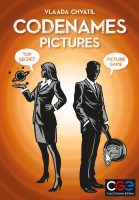
Codenames: Pictures
2-8
10+
15
What are these strange symbols on the map? They code for locations where spies must contact secret agents!
Two rival spymasters know the agent in each location. They deliver coded messages telling their field operatives where to go for clandestine meetings. Operatives must be clever. A decoding mistake could lead to an unpleasant encounter with an enemy agent – or worse, with the assassin!
Both teams race to contact all their agents, but only one team can win.
Codenames: Pictures differs from the original Codenames - Pictures in that the agents are no longer represented by a single word, but by an image that contains multiple elements.
User Reviews (1)
Add a Review for "Codenames: Pictures"
You must be logged in to add a review.

The mechanics of Codenames: Picture is the same as in the original Codenames: Two teams appoint one member each to be a “Spymaster” who will give one-word clues to their team to help them identify that team’s codename cards. The first team to identify all of their own cards wins. If a team chooses the card assigned to the assassin, they lose.
It’s a very simple set-up and the rules are easily explained. I’ve found it doesn’t take more than a couple of rounds before everyone gets the idea.
This does not mean the game play is as simple as it sounds.
In the original Codenames, since all the cards were words, the Spymasters were constrained by not being allowed to give clues that included any of the codename words laid out or included parts of any of those words. This added a level of difficulty in choosing the best clue word, and sometimes resulted in forfeiting the turn when a Spymaster accidentally picked a forbidden word.
With Codenames: Pictures there’s no restriction on not using the exact word to describe any element on any picture card in the grid.
A question that comes up with new players is, “so, why can’t the Spymaster just say ‘duck’ to point to a card with a duck on it?” Ah, well she can, but that might only result in that team identifying the single card, while the challenge is to identify as many cards as possible each turn to beat the other team. There’s no joy or tension or creativity with each team picking out only one card each turn.
The fun is also partly in having everyone get a chance to play the Spymaster in order to understand the challenge of coming up with the best clue to uncover the most of their own team’s cards at one time … without giving away any of the opposing team’s cards or, worse, the assassin’s card. Even when Spymasters make mistakes — which is bound to happen — this often ends in hilarity and group in-jokes for years to come.
Great high-five moments come when a Spymaster brilliantly picks a word that helps her team uncover 5 cards that don’t at first glance have any obvious similarity.
Other times, when spy teammates are arguing over which card to pick from the clue, it might come down to ceding to the person who best understands the mind of the Spymaster and what he might be thinking.
YOU WILL PROBABLY NOT LIKE THIS GAME IF:
• you can’t take teasing when you mess up
• you tend to take words or pictures too literally; or you get hung up on only one possible meaning for a word or one possible interpretation of an image
• you find illustrated drawings difficult to interpret
• you don’t like team competitions, even very friendly light-hearted ones
YOU WILL PROBABLY LIKE THIS GAME IF:
• you really enjoy word association games
• you enjoy lateral thinking challenges
• you enjoy games with lots of social interaction and table chatter
• you often get together groups of 4 or more friends or family who might not otherwise play board games
• you enjoy games with minimal set-up and break down and explanation for new players
• you want a game that is playable in any language